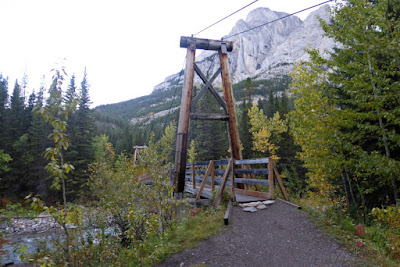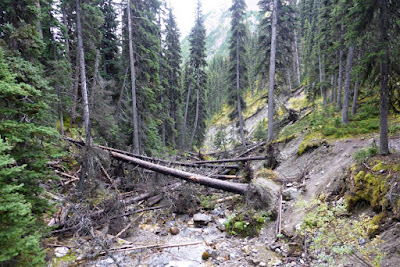Tuesday, Sept. 17 (2019). This was our last hike, the day for us to tackle our "goal" destination after two weeks in the mountains: Upper Galatea Lake. The previous year we'd made it almost to the lower lake, but weather and time had turned us back. We were determined to succeed this time. It would be work; it's a 18.6km/11.6 mile round-trip, gaining 806m/2644 feet to an altitude of 2230m/7316ft.
Joan and I rose early to have breakfast and then grab lunch fixings at the Market Cafe of Pomeroy Kananaskis. We drove out to the Galatea Lakes parking area and hit the trail at 8:00am.
After a brief downhill we reached the bridge across Galatea Creek.
In case you were tempted to ford it --Shortly thereafter we crossed a modest footbridge over a tributary flowing down from the mountains; this stream would be with us for miles. At the far side there was a trail sign. |
Left green circle, our destination. Right circle, our starting point.
|
The next section began with uphill switchbacks, followed by repeated crossings of the stream on replacement bridges,each revealing damage and wreckage from the floods of 2013. Joan and I would eventually cross ten bridges.
This first zone was largely in the woods. Then the trail climbed away from the creek and entered a zone of mixed woods and rock falls. In places the water had cut itself into a deep canyon.Joan and I noticed, along a short stretch, several spray-painted purple markings on the trail and finally a purpled stone sitting in the middle of the path. Trail maintenance markings, perhaps? Or hikers from a school with purple colors? Another mountain mystery.
The climb continued with more creek crossings. The way ahead did not yet appear any shorter.
A major landmark was a flat grove suitable for a pause and a bite.
 |
The grove continues to the right of this photo.
|
Over the last few years Joan and I have discovered the importance of snacks, particularly for me. Last year we made it all the way to Lillian Lake before eating anything, and Joan told me that by the end I was plodding in slow motion. After sharing a chocolate bar with her, I took off so fast she could barely keep up. (My fasting blood sugar is near the low end of normal). This time, we were stopping every 90 minutes or so for a small snack -- usually dark chocolate from Le Chocolatier -- and my efforts were much steadier.
Flood damage is visible most of the way to Lillian Lake.
After climbing a final, stubbornly steep stretch we emerged on her shores.
 |
This photo looks back the way we've come.
|
In season Lillian is mobbed by overnight campers, but in mid-September it was deserted. She does host, however, a spiffy solar-powered biffy, and most welcome it was.
After another chocolate stop Joan and I continued up wooded switchbacks until we emerged into the rocky zone.
 |
That saddle is Guinn's Pass, even higher than Galatea.
|
It's still uphill from here! Looking back at Lillian ...
The view from the shore of the lower lake on our return.We spotted our first fellow hikers of the day, two figures ahead of us on the Guinn's Pass trail, |
Click on the image to enlarge.
|
who disappeared from view as we marched on. When we reached the junction Joan and I met two women from Red Deer who also decided to tackle the pass. Then we saw people coming up from Lillian Lake; clearly, the wave of those who start later was catching up to us. |
On our way back ...
|
We paused on the Lillian Lake shore for another snack and biffy visit.Among the incoming hikers was family of three: Mom, Dad, and a toddler carried high in a backpack by Dad so the kid could see ahead. Balancing that load must be an acquired skill.A bold chipmunk kept an eye on us, probably a least chipmunk.
The sun played peek-a-boo, sharing time with brief showers that lasted just long enough to persuade us to don our rain jackets. But our return hike was basically dry.
 |
Heading down the valley.
|
The air grew warmer as we descended. Late-starters were having fun on and around the bridges lower down. Finally Joan and I reached the parking area at 5:15, 9¼ hours after setting out, a pace of 1.15 miles per hour -- including snack stops, lunch, bird identifying, gazing at mountains, and so forth. Because of these factors our hikes are often in the 1¼ to 1½ mph range.One woman in the parking area, with husband and dog waiting in the wings, asked Joan, "How far is it?" Joan replied,"Where are you going?" Her response, "Where did you go?" Joan: "We started at 8:00!" With that our questioner lost interest.
The following day was our last in this visit, and after checking out we drove down to Canmore to browse shops and art galleries. Of course, we swung by Le Chocolatier to pick up treats for ourselves and friends and neighbors back home. Large interior windows provided a view into the works.
We also spotted a hang glider gradually descending over the town!Then it was on to Calgary and the airport hotel, where we had dinner with Barry Ronellenfitch, who I met almost two decades earlier at a retreat. The next morning Joan and I flew off on a day-long trip back home.This Canadian visit was another great success; we do love the mountains. Our plans for 2020 were made over the next few months, but then upended by the coronavirus. Our fingers are crossed for 2021.




























































